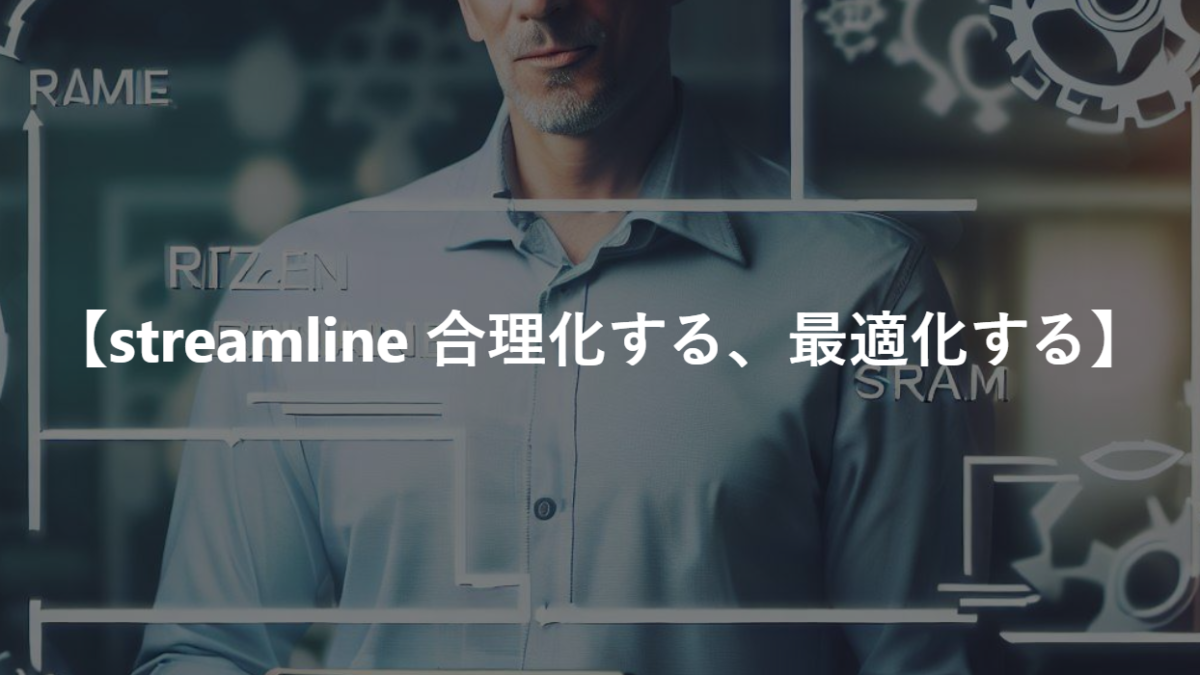語源・類義語・反対語・例文
【streamline 合理化する、最適化する】という単語の語源とか由来を知っていますか?
「Streamline」という単語は、もともと流体力学から来ています。この用語は、流れの中で物体の形状が流体(水や空気など)の流れを妨げないように設計されていることを指します。つまり、物体が流体の抵抗を最小限に抑えるように「最適化される」という意味です。この概念は、水中や空中を移動する物体の形状を指すために使われ、その形状が流線型(streamlined)であるとき、その物体は効率よく動くことができます。
20世紀に入ると、「streamline」は比喩的な意味でも使われるようになりました。ビジネスや製造、組織運営などの文脈で、プロセスや手続きを「合理化する」や「最適化する」という意味で用いられるようになったのです。この場合、不必要な部分を取り除き、効率を高めることを意味します。つまり、プロセスをスムーズにし、時間や資源の無駄を減らすための方法や手段を指すようになりました。
The term “streamline” originally comes from fluid dynamics. This term refers to the design of an object’s shape so that it does not obstruct the flow of a fluid (such as water or air). It means that the object is “optimized” to minimize resistance from the fluid. This concept is used to describe the shape of objects moving through water or air, and when an object is in a streamlined shape, it can move more efficiently.
Entering the 20th century, “streamline” began to be used in a metaphorical sense as well. In contexts such as business, manufacturing, or organizational management, it started being used to mean “to make more efficient” or “to optimize” in terms of processes or procedures. In this case, it implies removing unnecessary parts to enhance efficiency. Thus, it refers to methods or means to make processes smoother and to reduce waste of time or resources.
類義語・反対語は?それぞれの意味の日本語も併記してもらえますか?
類義語:
- Simplify – 簡略化する: 複雑なものをより簡単かつ理解しやすい形にする。
- Optimize – 最適化する: 最も効率的または効果的にする。
- Rationalize – 合理化する: 理にかなった形にするまたは論理的に説明する。
- Improve – 改善する: より良い状態にする。
- Modernize – 現代化する: 最新の標準や方法に更新する。
- Reorganize – 再編成する: より効率的または組織的な構造に再構成する。
- Enhance – 強化する: 品質や価値を高める。
- Refine – 精緻化する: 細部を改善して完璧にする。
- Streamline – 合理化する: 無駄を省き、効率を高める。
- Consolidate – 統合する: 複数の要素を一つにまとめる。
反対語:
- Complicate – 複雑化する: より複雑または困難にする。
- Confuse – 混乱させる: 理解または区別が難しくなるようにする。
- Expand – 拡大する: より大きくまたは広範囲にする。
- Disorganize – 無秩序にする: 秩序や組織を乱す。
- Compromise – 妥協する: 標準を下げるまたは原則を曲げる。
- Deteriorate – 悪化する: より悪い状態になる。
- Fragment – 分割する: 小さな部分に分ける。
- Clutter – 散らかす: 不要なもので満たす。
- Obstruct – 妨げる: 進行や過程を妨害する。
- Regress – 後退する: より低い状態やレベルに戻る。
この単語に似た単語で間違いやすい単語はありますか?
「Streamline」に似ていて間違えやすい単語は特にないですが、似たような意味を持つ単語や、発音が似ている単語で混同されることがあります。例えば、「streamline」と「streaming」は発音が似ていますが、意味は大きく異なります。「streaming」は、インターネットを通じて音楽やビデオを連続的に再生することを意味しますが、「streamline」はプロセスや手順を合理化することを指します。
また、「streamline」と似た意味を持つ単語である「simplify」(簡略化する)や「optimize」(最適化する)は、目的やコンテキストによって使い分ける必要があります。しかし、これらの単語は「合理化する」や「効率的にする」という意味合いで近いため、文脈に応じて誤って使用されることがあります。
しかし、特に「streamline」と混同しやすい類似の単語が存在するわけではありません。主に、その使用文脈に基づいて、適切な単語を選択する必要があります。
この単語を使った例文を5つほど教えてください。
The company implemented new strategies to streamline its operations and reduce costs.
(会社は業務を合理化し、コストを削減するために新しい戦略を導入しました。)
The government aims to streamline the bureaucratic processes to improve efficiency and responsiveness.
(政府は官僚的な手続きを合理化し、効率と迅速性を向上させることを目指しています。)
The design of the car was streamlined to reduce drag and improve fuel efficiency.
(その車のデザインは抵抗を減らし、燃費を改善するために合理化されました。)
The company streamlined its supply chain by implementing automated inventory management systems.
(会社は自動化された在庫管理システムを導入することで、サプライチェーンを合理化しました。)
The team conducted a thorough review of the workflow to identify areas that could be streamlined for better productivity.
(チームは業務フローを徹底的に見直し、生産性を向上させるために合理化できる領域を特定しました。)
【streamline 合理化する、最適化する】のコロケーション
- Streamline operations – 業務を合理化する: 組織や企業の運営をより効率的にするために、不必要な手順やプロセスを省略または改善することを意味します。
- Streamline processes – プロセスを合理化する: 仕事の流れや手続きを単純化し、時間やリソースの無駄を減らすことを指します。目的は、生産性を高め、コストを削減することです。
- Streamline workflow – ワークフローを最適化する: 作業の進行をスムーズにし、効率的にするために、業務の流れを整理することを意味します。これにより、作業の遅延や混乱を減らすことができます。
- Streamline management – 管理を合理化する: 管理手法を改善し、より効果的な監督と意思決定を促進することを指します。これには、コミュニケーションの改善や意思決定プロセスの単純化が含まれることがあります。
- Streamline communication – コミュニケーションを合理化する: 情報の伝達方法を簡素化し、よりクリアで効率的なコミュニケーションを実現することを意味します。これにより、誤解を減らし、作業の効率を向上させることができます。
「Streamline」(合理化する、最適化する)という単語は、ビジネスや組織の運営において、業務の効率化と生産性の向上を目的として広く使用されています。この用語は、特に業務プロセス、作業フロー、経営管理などの分野での改善に焦点を当てた場合に重要です。
業務を合理化すること、すなわち「Streamline operations」では、組織の日常的な運営をより効率的にするために、不要なステップやプロセスを削除または簡素化することが求められます。これにより、時間とリソースの節約が実現し、全体的な業務効率が向上します。
また、「Streamline processes」というフレーズでは、個々の作業プロセスの最適化を通じて、作業の品質と速度を高めることが目標とされます。これは、生産性を向上させるだけでなく、コスト削減にもつながります。
「Streamline workflow」という表現は、日々の作業の流れを整理し、よりスムーズで効率的な方法でタスクを完了させることを意味します。こうすることで、作業の遅延や混乱を最小限に抑え、従業員の生産性を最大化することができます。
「Streamline management」では、管理手法そのものを見直し、効果的な監督と迅速な意思決定を促進することが目指されます。これにより、組織全体のパフォーマンスが向上し、より良い結果を得ることができます。
最後に、「Streamline communication」は、コミュニケーションの方法を改善し、情報の伝達をより明確で効率的にすることを目指します。これにより、誤解が減少し、チームワークが向上します。
これらのコロケーションを通じて、「streamline」という単語は、組織や個人がより効率的かつ効果的に業務を遂行するための手段として、重要な役割を果たしていることがわかります。
The term “streamline” (to make more efficient or optimize) is widely used in business and organizational management to aim for improved efficiency and increased productivity. This term is particularly significant when focusing on improvements in areas such as operational processes, work flows, and management practices.
In “Streamline operations,” the goal is to make the everyday running of an organization more efficient by eliminating or simplifying unnecessary steps or processes. This leads to savings in time and resources, thereby enhancing overall operational efficiency.
The phrase “Streamline processes” targets the optimization of individual work processes to improve the quality and speed of work. This not only increases productivity but also contributes to cost reduction.
“Streamline workflow” refers to organizing the daily flow of work to complete tasks in a smoother and more efficient manner. By doing so, delays and confusion in tasks are minimized, maximizing employee productivity.
In “Streamline management,” the focus is on revising management practices to foster effective supervision and prompt decision-making. This improves the performance of the entire organization, leading to better outcomes.
Finally, “Streamline communication” aims to improve the way communication is conducted, making information transmission clearer and more efficient. This reduces misunderstandings and enhances teamwork.
Through these collocations, the word “streamline” plays a crucial role as a means for organizations and individuals to conduct their tasks more efficiently and effectively.
文法問題: “streamline” (合理化する、最適化する)
- 動詞の形:
The company decided to _________ its operations to reduce costs and increase efficiency.
(A) streamline
(B) streamlined
(C) streamlining
(D) streamlines
解答と解説:
(A) streamline 不定詞 “to” の後には動詞の原形が来ます。
– - 目的語との組み合わせ:
The new software helps to _________ the workflow and eliminate unnecessary steps.
(A) streamline
(B) streamline for
(C) streamline on
(D) streamline with
解答と解説:
(A) streamline streamline は他動詞で、目的語を直接取ります。前置詞は不要です。
– - 過去分詞形:
The _________ process saved the company time and money.
(A) streamline
(B) streamlined
(C) streamlining
(D) streamlines
解答と解説:
(B) streamlined 空欄には名詞 process を修飾する形容詞が必要です。streamlined は「合理化された」「無駄のない」という意味の過去分詞形の形容詞です。
– - 類義語:
The manager sought to _________ the company’s operations by eliminating redundant processes.
(A) streamline
(B) simplify
(C) optimize
(D) all of the above
解答と解説:
(D) all of the above streamline, simplify, optimize はいずれも「合理化する」「簡素化する」という意味で、この文脈ではすべて適切です。
– - 誤文訂正:
The streamlining of the production process resulted in a significant increase in output.
解答と解説:
誤りはありません。 この文は、「生産工程の合理化により、生産量が大幅に増加した」という意味で、streamlining が正しく使われています。

